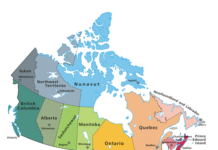They kept on coming in attached to trout and salmon. They are the blood sucking fish killing sea lamprey, featured in a display at the 34th annual Owen Sound SALMON SPECTACULAR derby. All week anglers were bringing in fish with lamprey attached or lamprey they had pulled from fish they caught.

There is a lot of learning to do at this booth at the north end of the giant derby tent. Some raw facts about sea lamprey:
– sea lampreys are parasitic pests
– they attach to fish with their suction mouth and teeth using their tongue to rasp through a fish’s scales and skin so they can feed on its blood
– for every 7 fish attacked by lamprey, 6 will die
– a single sea lamprey will destroy up to 18 kg (40 lbs.) of fish during its adult lifetime
The updated display at the derby tent, now in its 8th year, is a sensation among young people. In fact kids of all ages are fascinated by the squirming slimy creatures.
For larger view, Click on Image
They gaze in wonder and sometimes giggle, when the creatures are pulled from the display tank to show off the powerful suction capability that allows them puncture the skin of fish and drain their fluids.
The Great Lakes Fishery Commission, which is responsible for the lamprey file says “we have sea lamprey under control….we continue to develop new methods of keeping their numbers down to record low levels.”
The 200-member Wiarton based Bruce Peninsula Sportsmen’s Association (BPSA) supports the commission’s battle against lamprey. As does the Sydenham Sportsmen Association which mounts the Salmon Spectacular. Each year BPSA volunteers at the display help spread news about this invasive and the campaign to keep lamprey populations down.
Sea lampreys are native to the Atlantic Ocean, but thanks to locks and shipping canals, they found their way into the Great Lakes in the 1800s where, because they prey on whitefish, lake trout and salmon, they’ve disrupted the freshwater ecosystem.
It is clear without the continuing efforts of the Great Lakes Fishery Commission, we would not have sports or commercial fisheries in our Great Lakes.
The Great Lakes Fishery Commission was established in 1955 by the Canadian/U.S. Convention on Great Lakes Fisheries. The commission coordinates fisheries research, controls the invasive sea lamprey, and facilitates cooperative fishery management among state, provincial, tribal, and federal agencies.
For more on the sea lamprey threat to our Great Lakes visit: http://www.glfc.org/pubs/factsheets/FastFactsAboutSLsFactSheet.pdf
















